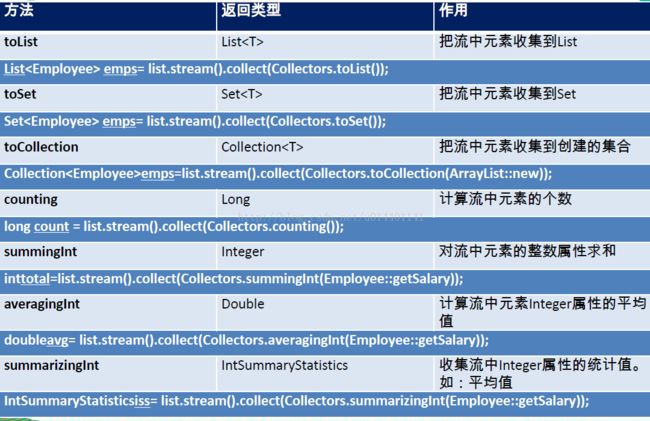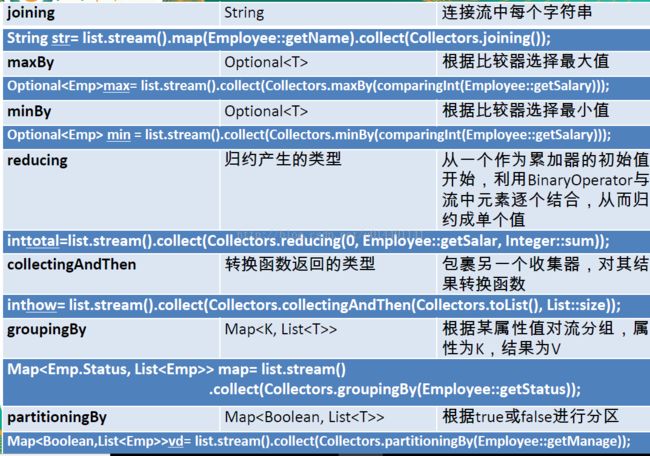java8新特性之Stream API(二)
1.Stream API是什么
Java8中有两大最为重要的改变。第一个是Lambda 表达式;另外一个则是Stream API(java.util.stream.*)。
Stream 是Java8 中处理集合的关键抽象概念,它可以指定你希望对集合进行的操作,可以执行非常复杂的查找、过滤和映射数据等操作。使用Stream API 对集合数据进行操作,就类似于使用SQL 执行的数据库查询。也可以使用Stream API 来并行执行操作。简而言之,Stream API 提供了一种高效且易于使用的处理数据的方式。
流(Stream) 到底是什么呢?
是数据渠道,用于操作数据源(集合、数组等)所生成的元素序列。“集合讲的是数据,流讲的是计算!”
注意:
①Stream 自己不会存储元素。
②Stream 不会改变源对象。相反,他们会返回一个持有结果的新Stream。
③Stream 操作是延迟执行的。这意味着他们会等到需要结果的时候才执行。
Stream 的操作三个步骤
创建Stream
一个数据源(如:集合、数组),获取一个流
中间操作
一个中间操作链,对数据源的数据进行处理
终止操作(终端操作) ----一个终止操作,执行中间操作链,并产生结果
2.创建Stream
2.1集合创建Stream
Java8 中的Collection 接口被扩展,提供了两个获取流的方法:
default Stream
default Stream
2.2由数组创建流
Java8 中的Arrays 的静态方法stream() 可以获取数组流:
static
重载形式,能够处理对应基本类型的数组:
public static IntStream stream(int[] array)
public static LongStream stream(long[] array)
public static DoubleStream stream(double[] array)
2.3由值创建流
可以使用静态方法Stream.of(), 通过显示值创建一个流。它可以接收任意数量的参数。
public static
2.4由函数创建流:创建无限流
可以使用静态方法Stream.iterate() 和Stream.generate(), 创建无限流。
迭代
public static Stream iterate(final T seed, final UnaryOperator f)
生成
public static Stream generate(Supplier s);
示例:
//1. 创建 Stream
@Test
public void test1(){
//1. Collection 提供了两个方法 stream() 与 parallelStream()
List list = new ArrayList<>();
Stream stream = list.stream(); //获取一个顺序流
Stream parallelStream = list.parallelStream(); //获取一个并行流
//2. 通过 Arrays 中的 stream() 获取一个数组流
Integer[] nums = new Integer[10];
Stream stream1 = Arrays.stream(nums);
//3. 通过 Stream 类中静态方法 of()
Stream stream2 = Stream.of(1,2,3,4,5,6);
//4. 创建无限流
//迭代
Stream stream3 = Stream.iterate(0, (x) -> x + 2).limit(10);
stream3.forEach(System.out::println);
//生成
Stream stream4 = Stream.generate(Math::random).limit(2);
stream4.forEach(System.out::println);
}
3.Stream 的中间操作
多个中间操作可以连接起来形成一个流水线,除非流水线上触发终止操作,否则中间操作不会执行任何的处理!
而在终止操作时一次性全部处理,称为“惰性求值”。
筛选与切片
filter(Predicatep) 接收Lambda ,从流中排除某些元素。
distinct() 筛选,通过流所生成元素的hashCode() 和equals() 去除重复元素
limit(long maxSize) 截断流,使其元素不超过给定数量。
skip(long n) 跳过元素,返回一个扔掉了前n 个元素的流。若流中元素不足n 个,则返回一个空流。与limit(n) 互补
示例:
//2. 中间操作
List emps = Arrays.asList(
new Employee(102, "李四", 59, 6666.66),
new Employee(101, "张三", 18, 9999.99),
new Employee(103, "王五", 28, 3333.33),
new Employee(104, "赵六", 8, 7777.77),
new Employee(104, "赵六", 8, 7777.77),
new Employee(104, "赵六", 8, 7777.77),
new Employee(105, "田七", 38, 5555.55)
);
/*
筛选与切片
filter——接收 Lambda , 从流中排除某些元素。
limit——截断流,使其元素不超过给定数量。
skip(n) —— 跳过元素,返回一个扔掉了前 n 个元素的流。若流中元素不足 n 个,则返回一个空流。与 limit(n) 互补
distinct——筛选,通过流所生成元素的 hashCode() 和 equals() 去除重复元素
*/
//内部迭代:迭代操作 Stream API 内部完成
@Test
public void test2(){
//所有的中间操作不会做任何的处理
Stream stream = emps.stream().filter((e)->e.getAge()>30);
//只有当做终止操作时,所有的中间操作会一次性的全部执行,称为“惰性求值”
stream.forEach(System.out::println);
}
@Test
public void test4(){
emps.stream()
.filter((e) -> {
System.out.println("短路!"); // && ||
return e.getSalary() >= 5000;
}).limit(3)
.forEach(System.out::println);
}
结果:
短路!
Employee [id=102, name=李四, age=59, salary=6666.66]
短路!
Employee [id=101, name=张三, age=18, salary=9999.99]
短路!
短路!
Employee [id=104, name=赵六, age=8, salary=7777.77]
@Test
public void test5(){
emps.parallelStream()
.skip(2)
.forEach(System.out::println);
}
@Test
public void test6(){
emps.stream()
.distinct()
.forEach(System.out::println);
}
映射
map(Function f)
接收一个函数作为参数,该函数会被应用到每个元素上,并将其映射成一个新的元素。
mapToDouble(ToDoubleFunction f)
接收一个函数作为参数,该函数会被应用到每个元素上,产生一个新的DoubleStream。
mapToInt(ToIntFunction f)
接收一个函数作为参数,该函数会被应用到每个元素上,产生一个新的IntStream。
mapToLong(ToLongFunction f)
接收一个函数作为参数,该函数会被应用到每个元素上,产生一个新的LongStream。
flatMap(Function f)
接收一个函数作为参数,将流中的每个值都换成另一个流,然后把所有流连接成一个流
/*
映射
map——接收 Lambda , 将元素转换成其他形式或提取信息。接收一个函数作为参数,该函数会被应用到每个元素上,并将其映射成一个新的元素。
flatMap——接收一个函数作为参数,将流中的每个值都换成另一个流,然后把所有流连接成一个流
*/
@Test
public void test1(){
Stream str = emps.stream()
.map((e) -> e.getName());
str.forEach(System.out::println);
System.out.println("-------------------------------------------");
List strList = Arrays.asList("aaa", "bbb", "ccc", "ddd", "eee");
Stream stream = strList.stream()
.map(String::toUpperCase);
stream.forEach(System.out::println);
System.out.println("---------------------------------------------");
Stream> stream2 = strList.stream()
.map(TestStreamAPI1::filterCharacter);
stream2.forEach((sm) -> {
sm.forEach(System.out::println);
});
System.out.println("---------------------------------------------");
Stream stream3 = strList.stream()
.flatMap(TestStreamAPI1::filterCharacter);
stream3.forEach(System.out::println);
}
public static Stream filterCharacter(String str){
List list = new ArrayList<>();
for (Character ch : str.toCharArray()) {
list.add(ch);
}
return list.stream();
}
排序
sorted() 产生一个新流,其中按自然顺序排序
sorted(Comparator comp) 产生一个新流,其中按比较器顺序排序
/*
sorted()——自然排序
sorted(Comparator com)——定制排序
*/
@Test
public void test2(){
emps.stream()
.map(Employee::getName)
.sorted()
.forEach(System.out::println);
System.out.println("------------------------------------");
emps.stream()
.sorted((x, y) -> {
if(x.getAge() == y.getAge()){
return x.getName().compareTo(y.getName());
}else{
return Integer.compare(x.getAge(), y.getAge());
}
}).forEach(System.out::println);
}
对象中按日期属性排序
User user1=new User("TEST1",11,new Date());
Thread.sleep(1000);
User user3=new User("TEST2",12,new Date());
Thread.sleep(1000);
User user4=new User("TEST3",13,new Date());
Thread.sleep(1000);
User user2=new User("TEST4",14,new Date());
Thread.sleep(1000);
List list=new ArrayList<>();
list.add(user1);
list.add(user2);
list.add(user3);
list.add(user4);
List list2= list.stream().sorted((a,b)->{
return Long.compare(a.getBirthDate().getTime(),b.getBirthDate().getTime());
}).collect(Collectors.toList());
list2.stream().forEach(o-> System.out.println(o.getAge()));
4.Stream 的终止操作
终端操作会从流的流水线生成结果。其结果可以是任何不是流的值,例如:List、Integer,甚至是void 。
查找与匹配
allMatch(Predicate p) 检查是否匹配所有元素
anyMatch(Predicate p) 检查是否至少匹配一个元素
noneMatch(Predicate p) 检查是否没有匹配所有元素
findFirst() 返回第一个元素
findAny() 返回当前流中的任意元素
count() 返回流中元素总数
max(Comparator c) 返回流中最大值
min(Comparator c) 返回流中最小值
forEach(Consumerc)
内部迭代(使用Collection 接口需要用户去做迭代,称为外部迭代。相反,Stream API 使用内部迭代——它帮你把迭代做了)
示例:
List emps = Arrays.asList(
new Employee(102, "李四", 59, 6666.66, Employee.Status.BUSY),
new Employee(101, "张三", 18, 9999.99, Employee.Status.FREE),
new Employee(103, "王五", 28, 3333.33, Employee.Status.VOCATION),
new Employee(104, "赵六", 8, 7777.77, Employee.Status.BUSY),
new Employee(104, "赵六", 8, 7777.77, Employee.Status.FREE),
new Employee(104, "赵六", 8, 7777.77, Employee.Status.FREE),
new Employee(105, "田七", 38, 5555.55, Employee.Status.BUSY)
);
//3. 终止操作
/*
allMatch——检查是否匹配所有元素
anyMatch——检查是否至少匹配一个元素
noneMatch——检查是否没有匹配的元素
findFirst——返回第一个元素
findAny——返回当前流中的任意元素
count——返回流中元素的总个数
max——返回流中最大值
min——返回流中最小值
*/
@Test
public void test1(){
boolean bl = emps.stream()
.allMatch(x->x.getAge()>0);
System.out.println(bl);
boolean bl1 = emps.stream()
.anyMatch((e) -> e.getStatus().equals(Employee.Status.BUSY));
System.out.println(bl1);
boolean bl2 = emps.stream()
.noneMatch((e) -> e.getStatus().equals(Employee.Status.BUSY));
System.out.println(bl2);
}
@Test
public void test2(){
Optional op = emps.stream()
.sorted((e1, e2) -> Double.compare(e1.getSalary(), e2.getSalary()))
.findFirst();
System.out.println(op.get());
System.out.println("--------------------------------");
Optional op2 = emps.parallelStream()
.filter((e) -> e.getStatus().equals(Employee.Status.FREE))
.findAny();
System.out.println(op2.get());
}
@Test
public void test3(){
long count = emps.stream()
.filter((e) -> e.getStatus().equals(Employee.Status.FREE))
.count();
System.out.println(count);
Optional op = emps.stream()
.map(Employee::getSalary)
.max(Double::compare);
System.out.println(op.get());
Optional op2 = emps.stream()
.min((e1, e2) -> Double.compare(e1.getSalary(), e2.getSalary()));
System.out.println(op2.get());
}
//注意:流进行了终止操作后,不能再次使用
@Test
public void test4(){
Stream stream = emps.stream()
.filter((e) -> e.getStatus().equals(Employee.Status.FREE));
long count = stream.count();
stream.map(Employee::getSalary)
.max(Double::compare);
}
归约
reduce(T iden, BinaryOperator b)
可以将流中元素反复结合起来,得到一个值。返回T
reduce(BinaryOperator b)
可以将流中元素反复结合起来,得到一个值。返回Optional
备注:map 和reduce 的连接通常称为map-reduce 模式,因Google 用它来进行网络搜索而出名。
示例:
/*
归约
reduce(T identity, BinaryOperator) / reduce(BinaryOperator) ——可以将流中元素反复结合起来,得到一个值。
*/
@Test
public void test1(){
List list = Arrays.asList(1,2,3,4,5,6,7,8,9,10);
Integer sum = list.stream()
.reduce(0, (x, y) -> x + y);
System.out.println(sum);
System.out.println("----------------------------------------");
Optional op = emps.stream()
.map(Employee::getSalary)
.reduce(Double::sum);
System.out.println(op.get());
}
收集
collect(Collector c)
将流转换为其他形式。接收一个Collector接口的实现,用于给Stream中元素做汇总的方法
Collector
接口中方法的实现决定了如何对流执行收集操作(如收集到List、Set、Map)。但是Collectors 实用类提供了很多静态方法,
可以方便地创建常见收集器实例,具体方法与实例如下表:
示例:
//collect——将流转换为其他形式。接收一个 Collector接口的实现,用于给Stream中元素做汇总的方法
@Test
public void test3(){
List list = emps.stream()
.map(Employee::getName)
.collect(Collectors.toList());
list.forEach(System.out::println);
System.out.println("----------------------------------");
List list2=emps.stream().map(Employee::getAge).collect(Collectors.toList());
list2.stream().forEach(System.out::println);
System.out.println("----------------------------------");
Set set = emps.stream()
.map(Employee::getName)
.collect(Collectors.toSet());
set.forEach(System.out::println);
System.out.println("----------------------------------");
HashSet hs = emps.stream()
.map(Employee::getName)
.collect(Collectors.toCollection(HashSet::new));
hs.forEach(System.out::println);
} 
